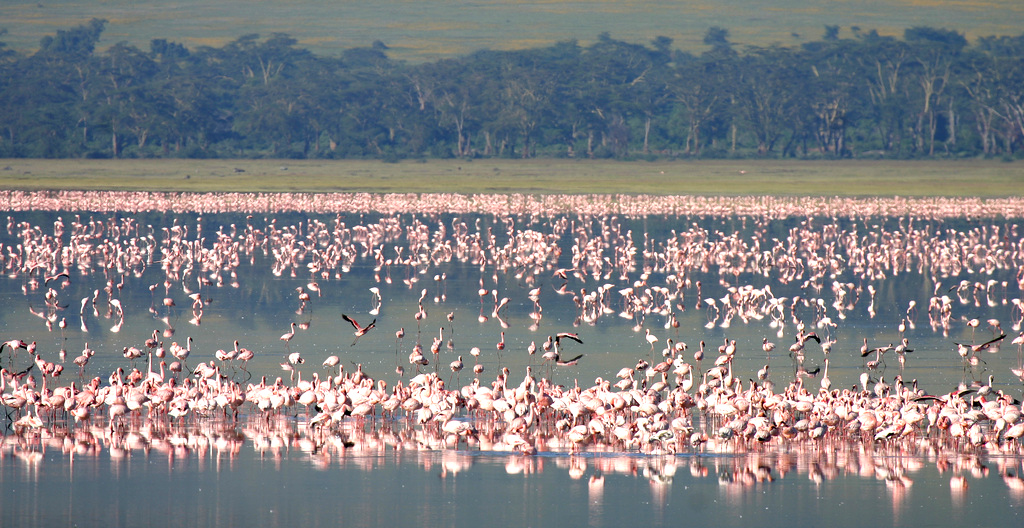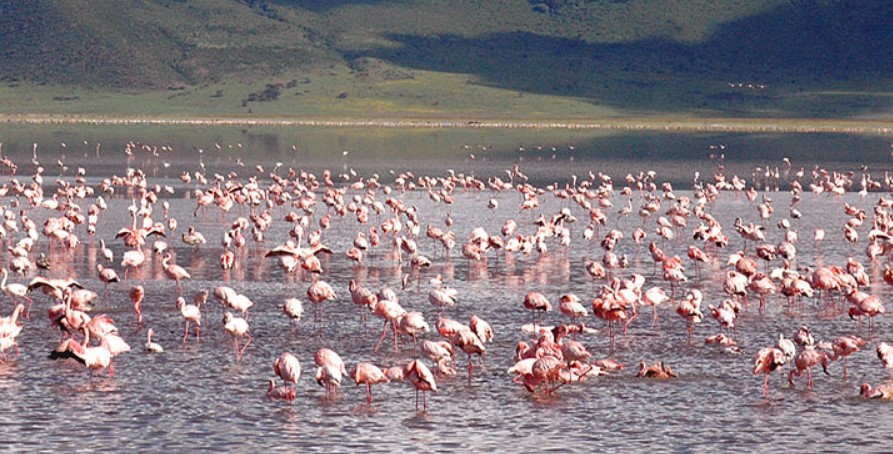Ngorongoro Crater Flamingos
Ngorongoro Crater Flamingos : While on Ngorongoro Crater safaris, one of the most breathtaking sights to view in the crater is the Ngorongoro Crater flamingos. The flamingos are Lesser Flamingos, or Phoeniconaias Minor in botanical terminology. In shallow, these birds thrive in salty and shallow water . The flamingos in Ngorongoro Crater can be found in Lake Magadi, a salty lake that draws enormous flocks of flamingos that visitors can see while on their safari drive around Ngorongoro Crater.

Flamingoes generally fee on the dead algae that is typically present in the salty lakes they inhabit. One of the flamingo species found in Africa is the lesser flamingo seen in the Crater. Lesser flamingos can be seen in the greatest numbers in Kenya’s Lake Nakuru and Lake Naivasha. Both Ngorongoro Crater Flamingos in Tanzania’s Lake Manyara National Park and Lake Magadi in the Crater are home to sizable flocks of flamingos.
The Greater Flamingo and the Lesser Flamingo are two of the four species of flamingos that can be found in the world. The larger size of Greater Flamingos distinguishes them from Lesser Flamingos. The Greater Flamingos are larger than the Lesser Flamingos and taller, towering 150 cm tall and weighing up to 4 kg.
Lesser Flamingos live in Tanzania’s Ngorongoro Crater. The flamingos are smaller and travel in vast flocks of more than a thousand birds. Therefore, flamingos in the Crater live in flocks and are extremely sociable. It is unusual to observe flamingos alone.
The small, alkaline Lake Magadi, which is located right in the center of the Ngorongoro Crater, is what draws the flamingos there. The term Lake Magadi, which literally means “salty,” comes from the Masai people who live nearby. Flamingos live in wetlands, lagoons, and wetlands in addition to shallow lakes. Flamingos in the Crater consume plankton, crabs, and brine shrimp in addition to dead algae. These flamingos in the Ngorongoro Crater have specialized bills that filter and separate waste from meals.
When feeding, flamingos have a peculiar feeding technique that you would want to witness while on a Tanzania safari tour of the Crater. The algae that they consume blooms in the alkaline Lake Magadi, which frequently turns pink when flamingos consume it, turning the flamingos themselves pink in the process.
The Ngorongoro Crater flamingos’ breeding season, which lasts from October to December, begins with the flamingos beginning to set up their nests. Flamingos construct nests and lay one egg, which is then incubated for 28 days by both the male and female flamingos. The tiny flamingos, which are grey in hue when they hatch, eat their eggshells while the adults consume the milky nectar. Both male and female flamingos feed the young chicks, giving them a milky substance to drink. The chicks spend just about a week in the nest before they are ready to leave and join the nursery. A flock of thousands of chicks cared for by a chosen few adult flamingos is called a crèche. One of the most stunning and distinctive characteristics of flamingos anywhere in the world is this lengthy process.
As was already said, flamingos may be found across Tanzania, not just on Ngorongoro Crater. Flamingos can also be found in the alkaline lakes of Lake Manyara in Tanzania’s renowned Ngorongoro Crater, Lake Natron, and Lake Magadi. Lake Manyara is located in Lake Manyara National Park.

The Ngorongoro Crater is home to a variety of animals. Travelers can witness more than 450 different bird species in the Ngorongoro Conservation Area while participating in a variety of activities there. In addition to the flamingos, visitors to Ngorongoro Crater can view a variety of other birds, such as the Secretary Bird, Hamerkop, Gray Heron, Great White Pelican, Long-Tailed Lapwing, and Speke’s Weaver.
The Ngorongoro Crater is one of the top birding locations in Tanzania thanks to the flamingos and other birds that make up the Crater’s estimated 450 different bird species. Here is the greatest place to go birding in Tanzania to see not only flamingos but a wide variety of other bird species as well as enjoy the other attractions in Ngorongoro Conservation Area.
Wildlife like the Ngorongoro Crater big 5 animals, sceneries, beauty, culture, and many more things make up Ngorongoro Crater Tanzania’s other attractions.
Among the numerous sights in Ngorongoro Carter, are the flamingos in the Ngorongoro Crater of interest? Get in touch with a reliable tour operator to assist you put together an incredible Tanzanian safari, particularly an incredible Ngorongoro Crater birding safari.
